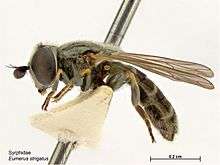Eumerus strigatus
Eumerus strigatus or lesser bulb fly is a species of Hoverfly, from the family Syrphidae, in the order Diptera.[2]
| Eumerus strigatus | |
|---|---|
 | |
| Eumerus strigatus | |
| Scientific classification | |
| Kingdom: | |
| Phylum: | |
| Class: | |
| Order: | |
| Family: | |
| Subfamily: | |
| Tribe: | |
| Genus: | |
| Species: | E. strigatus |
| Binomial name | |
| Eumerus strigatus (Fallén, 1817) | |
| Synonyms | |
Description
External images For terms, see: Morphology of Diptera.
Wing length: 4–6.25 mm (0.157–0.246 in). Stigma are yellowish or light brown. Femora 3 is simple. Tergites are blackish, absolutely without reddish-brown markings. Male ocelli are in an equilateral triangle. Male genitalia figured by Van Veen (2004).[3] [4] [5][6][7] The Larva is described and figured by Heiss (1938) .[8]
Distribution
Palaearctic, Fennoscandia South to Iberia and the Mediterranean basin, Ireland east through Europe into Turkey and Russia. Also, from the Urals to the Pacific coast (Sakhalin) and Japan. Introduced to the Nearctic and Australia and New Zealand.[9][10] [11]
Biology
The habitat is wetlands, deciduous woodland, open ground, seasonally-flooded grassland, and open, dry unimproved pasture, including dune grassland. Also in horticultural land and suburban gardens.[12] In dry grassland often settles on the ground, on stones etc. Flowers visited include umbellifers, Allium ursinum, Convolvulus, Eschscholzia californica, Euphorbia, Fragaria, Leontodon, Papaver, Potentilla erecta, Ranunculus, Sonchus arvensis, Taraxacum. The flight period is May to September. A bulb feeder. It is a minor pest of Liliaceae, parsnip, carrot, potato, asparagus, artichoke roots (Cynara scolymus).[13]
References
- Chandler, Peter J. (1998). "Checklists of Insects of the British Isles (New Series) Part 1: Diptera". Handbooks for the Identification of British Insects. 12. Royal Entomological Society: 1–234. Retrieved 20 March 2014. Cite journal requires
|journal=(help) - Stubbs, Alan E.; Falk, Steven J. (1983). British Hoverflies: An Illustrated Identification Guide. British Entomological & Natural History Society. pp. 253, xvpp.
- Van Veen, M. (2004) Hoverflies of Northwest Europe: identification keys to the Syrphidae. 256pp. KNNV Publishing, Utrecht.addendum
- Van der Goot,V.S. (1981) De zweefvliegen van Noordwest - Europa en Europees Rusland, in het bijzonder van de Benelux. KNNV, Uitgave no. 32: 275pp. Amsterdam.
- Bei-Bienko, G.Y. & Steyskal, G.C. (1988) Keys to the Insects of the European Part of the USSR, Volume V: Diptera and Siphonaptera, Part I. Amerind Publishing Co., New Delhi. ISBN 81-205-0080-6.
- Coe, R.L. (1953) Diptera: Syrphidae. Handbks.ident.Br.insects 10(1): 1-98. R. ent. Soc. London. pdf
- Bradescu, V. (1991) Les Syrphides de Roumanie (Diptera, Syrphidae), Clés de détermination et répartition. Trav.Mus.Hist. nat. Grigore Antipa, 31: 7-83.
- Heiss, E.M. (1938) A classification of the larvae and puparia of the Syrphidae of Illinois exclusive of aquatic forms. Univ.Illinois Bull. , 36: 1-142.
- Fauna Europaea
- Peck, L.V. (1988) Syrphidae. In: Soos, A. & Papp, L. (eds.) Catalogue of Palaearctic Diptera, 8: 11-230. Akad. Kiado, Budapest.
- Vockeroth, J.R. (1992). The Flower Flies of the Subfamily Syrphinae of Canada, Alaska, and Greenland (Diptera: Syrphidae). Part 18. The Insects and Arachnids of Canada. Ottawa, Ontario: Canadian Government Pub Centre. pp. 1–456. ISBN 0-660-13830-1.
- Speight, M.C.D. (2011). "Species accounts of European Syrphidae (Diptera)" (PDF). Syrph the Net, the database of European Syrphidae. 65: 285pp.
- de Buck, N. (1990). "Bloembezoek en bestuivingsecologie van Zweefvliegen (Diptera, Syrphidae) in het bijzonder voor België". Doc.Trav. IRSNB, no. 60, pp 1-167.